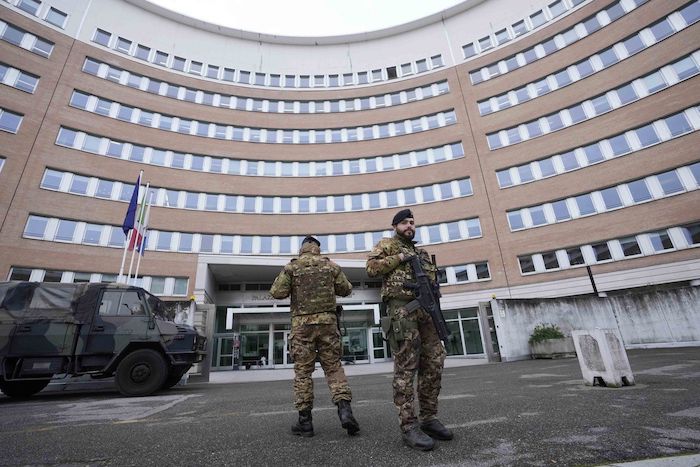Crime
Italy court weighs handover in EU Parliament corruption case

By Colleen Barry And Lorne Cook in Brescia
BRESCIA, Italy (AP) — An Italian court on Monday was deciding whether to hand over to Belgium a suspect in a big corruption scandal at the European Parliament, in which Belgian prosecutors suspect the wife and daughter of a former lawmaker of being part of a criminal gang trying to influence EU legislators on behalf of Qatar and Morocco.
According to arrest warrants seen Monday by The Associated Press, former EU lawmaker Pier Antonio Panzeri and three other suspects were charged on Dec. 9 with corruption, participation in a criminal group and money laundering. Belgian prosecutors suspect that they “were paid large sums of money or offered substantial gifts to influence parliament’s decisions.”
The investigation of allegations of cash and gifts for political influence corruption is one of the biggest to hit the European Parliament. Lawmakers last week suspended work on Qatar-related files and vowed to toughen lobbying laws. Qatar vehemently denies that it is involved.
According to the two European arrest warrants issued by Belgian judge Michel Claise, Panzeri is “suspected of intervening politically with members working at the European Parliament for the benefit of Qatar and Morocco, against payment.”
Panzeri’s wife, Maria Dolores Colleoni, and their daughter, Silvia Panzeri, are suspected of being “fully aware” of his activities and even to help transport “gifts” given by Morocco’s ambassador to Poland, Abderrahim Atmoun.
Prosecutors in Belgium are seeking their transfer to Belgium to face the same charges as the other four suspects, who include a former EU parliament vice president and her Italian partner. They face up to five years in prison if found guilty, according to the warrants.
A hearing was under way Monday in Brescia on whether to hand over Colleoni, while her daughter’s case will be heard separately on Tuesday. They are both under house arrest near Brescia, though Colleoni was in court on Monday. Panzeri himself is detained in Belgium.
Colleoni’s lawyer, Angelo de Riso, said handing her to Belgian authorities would violate her human rights because an Italian court has already conceded house arrest and a transfer to Belgium would land her in jail pending charges and trial.
A former vice president of the European Parliament, Eva Kaili, remains in custody in Belgium awaiting a hearing on Thursday. Her term in office was terminated by EU lawmakers last week. Her partner, Francesco Giorgi, was a parliamentary advisor.
Besides Panzeri, who leads the Fight Impunity campaign group, Niccolo Figa-Talamanca, secretary-general of the non-governmental organization No Peace Without Justice, was also charged. He has been released from prison but remains under surveillance and must wear an electronic monitoring bracelet.
Separately Monday, the former head of the Italian parliamentary committee on intelligence on Monday told reporters that a report on Qatar had been prepared and unanimously approved in August. The report has been classified and sealed, according to Adolfo Urso, now a minister in Premier Giorgia Meloni’s government. The report also includes China and Russia.
___
Cook reported from Brussels.
Crime
Brown University shooter dead of apparent self-inflicted gunshot wound

From The Center Square
By
Rhode Island officials said the suspected gunman in the Brown University mass shooting has been found dead of an apparent self-inflicted gunshot wound, more than 50 miles away in a storage facility in southern New Hampshire.
The shooter was identified as Claudio Manuel Neves-Valente, a 48-year-old Brown student and Portuguese national. Neves-Valente was found dead with a satchel containing two firearms inside in the storage facility, authorities said.
“He took his own life tonight,” Providence police chief Oscar Perez said at a press conference, noting that local, state and federal law officials spent days poring over video evidence, license plate data and hundreds of investigative tips in pursuit of the suspect.
Perez credited cooperation between federal state and local law enforcement officials, as well as the Providence community, which he said provided the video evidence needed to help authorities crack the case.
“The community stepped up,” he said. “It was all about groundwork, public assistance, interviews with individuals, and good old fashioned policing.”
Rhode Island Attorney General Peter Neronha said the “person of interest” identified by private videos contacted authorities on Wednesday and provided information that led to his whereabouts.
“He blew the case right open, blew it open,” Neronha said. “That person led us to the car, which led us to the name, which led us to the photograph of that individual.”
“And that’s how these cases sometimes go,” he said. “You can feel like you’re not making a lot of progress. You can feel like you’re chasing leaves and they don’t work out. But the team keeps going.”
The discovery of the suspect’s body caps an intense six-day manhunt spanning several New England states, which put communities from Providence to southern New Hampshire on edge.
“We got him,” FBI special agent in charge for Boston Ted Docks said at Thursday night’s briefing. “Even though the suspect was found dead tonight our work is not done. There are many questions that need to be answered.”
He said the FBI deployed around 500 agents to assist local authorities in the investigation, in addition to offering a $50,000 reward. He says that officials are still looking into the suspect’s motive.
Two students were killed and nine others were injured in the Brown University shooting Saturday, which happened when an undetected gunman entered the Barus and Holley building on campus, where students were taking exams before the holiday break. Providence authorities briefly detained a person in the shooting earlier in the week, but then released them.
Investigators said they are also examining the possibility that the Brown case is connected to the killing of a Massachusetts Institute of Technology professor in his hometown.
An unidentified gunman shot MIT professor Nuno Loureiro multiple times inside his home in Brookline, about 50 miles north of Providence, according to authorities. He died at a local hospital on Tuesday.
Leah Foley, U.S. attorney for Massachusetts, was expected to hold a news briefing late Thursday night to discuss the connection with the MIT shooting.
Crime
Bondi Beach Survivor Says Cops Prevented Her From Fighting Back Against Terrorists


From the Daily Caller News Foundation
A woman who survived the Hanukkah terrorist attack at Bondi Beach in Australia said on Monday that police officers seemed less concerned about stopping the attack than they were about keeping her from fighting back.
A father and son of Pakistani descent opened fire on a Hanukkah celebration Sunday, killing at least 15 people and wounding 40, with one being slain on the scene by police and the other wounded and taken into custody. Vanessa Miller told Erin Molan about being separated from her three-year-old daughter during Monday’s episode of the “Erin Molan Show.”
“I tried to grab one of their guns,” Miller said. “Another one grabbed me and said ‘no.’ These men, these police officers, they know who I am. I hope they are hearing this. You are weak. You could have saved so many more people’s lives. They were just standing there, listening and watching this all happen, holding me back.”
Dear Readers:
As a nonprofit, we are dependent on the generosity of our readers.
Please consider making a small donation of any amount here.
Thank you!
WATCH:
“Two police officers,” Miller continued. “Where were the others? Not there. Nobody was there.”
New South Wales Minister of Police Yasmin Catley did not immediately respond to a request for comment from the Daily Caller News Foundation about Miller’s comments.
Australian Prime Minister Anthony Albanese vowed to enact further restrictions on guns in response to the attack at Bondi Beach, according to the Associated Press. The new restrictions would include a limit on how many firearms a person could own, more review of gun licenses, limiting the licenses to Australian citizens and “additional use of criminal intelligence” to determine if a license to own a firearm should be granted.
Sajid Akram, 50, and Naveed Akram, 24, reportedly went to the Philippines, where they received training prior to carrying out the Sunday attack, according to the Australian Broadcasting Corporation. Naveed Akram’s vehicle reportedly had homemade ISIS flags inside it.
Australia passed legislation that required owners of semi-automatic firearms and certain pump-action firearms to surrender them in a mandatory “buyback” following a 1996 mass shooting in Port Arthur, Tasmania, that killed 35 people and wounded 23 others. Despite the legislation, one of the gunmen who carried out the attack appeared to use a pump-action shotgun with an extended magazine.
-

 Business1 day ago
Business1 day ago“Magnitude cannot be overstated”: Minnesota aid scam may reach $9 billion
-

 Haultain Research9 hours ago
Haultain Research9 hours agoSweden Fixed What Canada Won’t Even Name
-

 Business1 day ago
Business1 day agoLargest fraud in US history? Independent Journalist visits numerous daycare centres with no children, revealing massive scam
-

 Censorship Industrial Complex1 day ago
Censorship Industrial Complex1 day agoUS Under Secretary of State Slams UK and EU Over Online Speech Regulation, Announces Release of Files on Past Censorship Efforts
-

 Daily Caller2 days ago
Daily Caller2 days agoIs Ukraine Peace Deal Doomed Before Zelenskyy And Trump Even Meet At Mar-A-Lago?
-

 Business9 hours ago
Business9 hours agoWhat Do Loyalty Rewards Programs Cost Us?








